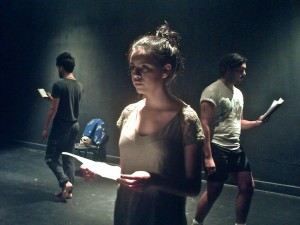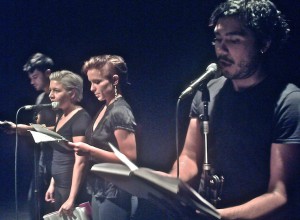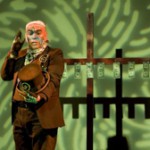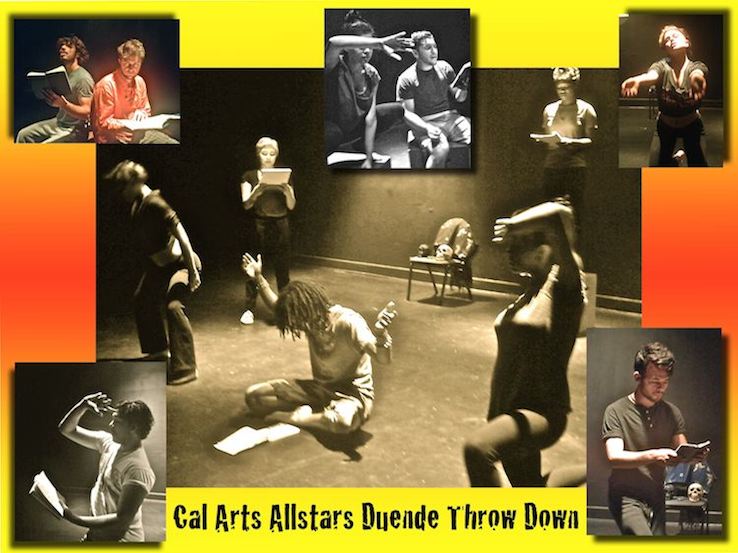Article by José Torres-Tama
I see performance art as the bastard child from a drunken one-night stand between the visual arts and theater, and neither wants to claim this hybrid offspring at times.
For the past twenty years, I have employed performance art as a conceptual umbrella to cover my genre-fusing provocations because it allows unmatched artistic freedoms, unfettered expression and invention. It’s an open and expansive cauldron for my deep-sea explorations into the murky waters of racial relations in the United States, and its not-far-from-the-surface puritanical Atlantis hiding a tormented history of genocide, slavery, and the support of brutal dictatorships that have kept my América Latina in a subservient paradigm.
Performance art is a conceptual framework, a point of departure, an artful strategy to speak the unspoken, visualize taboos, inspire outrage against the machine, confront the white supremacist conservative politics of the Christian right, and disturb the complacent psyche of audiences submerged in the passivity that their endless TV watching demands. Yes, passivity is stipulated by the omnipresent high definition plasma squeezebox, and the only action it requires is consumerism disguised as freedom.
BUY MORE AND SAVE YOURSELF!
BUY MORE AND SAVE DEMOCRACY!
BUY MORE AND SAVE OR THE TERRORISTS WIN!
In contrast, performance art is a “live art” form that may even engage you in actions of your own because it dares you to “perform” against the passivity of consumerism and the trained voyeurism of our culture. Likewise, traditional theatre requires that you politely sit still and “watch” the “staged show” that has been infinitely rehearsed for you, whereas performance art places you in the “live sphere of a cognizant space” where the audience and the performer/s are aware of each other’s existence. The performer/s may talk to you directly and may want you to talk back, breaking a fourth wall that is rendered useless and unnecessary to the living ritual.
 Confession: Secretly, I often want the audience to become so riotous that they leave the performance and take to the streets to begin the social change that I advocate and hope to inspire; change to stop the condoned police brutality against all people of color across FreedomLandia; change to criminally convict the government despots who did nothing as people died in my beloved city of New Orleans after Katrina and the levee breaches; Si se puede change to halt the millions of immigrant deportations under the watch of the first biracial president who is the son of an African immigrant; change to oppose the insidious means in which the U.S. has positioned itself as corporate ruler of the world by using “democracy” as its righteous sword when in fact it is capitalistic imperialism being pimped, while the “free trade” banner becomes another doublespeak ad to promote international exploitation of labor at all negligence to human rights.
Confession: Secretly, I often want the audience to become so riotous that they leave the performance and take to the streets to begin the social change that I advocate and hope to inspire; change to stop the condoned police brutality against all people of color across FreedomLandia; change to criminally convict the government despots who did nothing as people died in my beloved city of New Orleans after Katrina and the levee breaches; Si se puede change to halt the millions of immigrant deportations under the watch of the first biracial president who is the son of an African immigrant; change to oppose the insidious means in which the U.S. has positioned itself as corporate ruler of the world by using “democracy” as its righteous sword when in fact it is capitalistic imperialism being pimped, while the “free trade” banner becomes another doublespeak ad to promote international exploitation of labor at all negligence to human rights.
Oh, I have a dream! Porque el sueño sabe mas que tu.
Performance art allows me these fantastic dreams: To think that I can make a difference in a country that would prefer to starve me and other performance artists into silence; to feel empowered in a system that wants to render me powerless and superfluous as an artist; to engage in creative activity where politics and art are not antithetical but symbiotic; to stand on a paper constitution that has little truth for the dark one and buckles under our weight.
The reason performance artists have been continuously attacked by Republican “family values” fanatics is because of our daringness to challenge fascist ideologies disguised as patriotism, and our willingness to expose the hidden truths of oppressive policies, and engage in critical political discourse with our art making, our bodies, and our charged psyches.
As a Latino immigrant and person of color, a brown Mestizó male in the U.S., I do not have the luxury to make “art for art’s sake” and engage in indulgent esoteric practices to explore “form” and “meaningless abstract concerns.” The issues threatening my politicized body and the bodies of my endangered immigrant communities are much too urgent. If I have the opportunity, I have to speak of their pain, subjugation, and marginalization—not because it’s fashionable arts jargon for grant applications, but because, in fact, it mirrors my personal experiences with Eurocentric U.S. culture.
Performance art has allowed me the opportunity to chronicle my “disjointed narratives” as a Latino immigrant on university stages, art galleries, and alternative theater spaces across the country and internationally—serving as a performed record through a pan-Latin prism to challenge the often negative associations prescribed to “minorities” or people of non-European descent: “the brown, black, yellow, or red other.”
These beliefs are propagated through the omnipresent and omnipotent medium of TV, which keeps us in a constant state of fear and distrust of each other and effectively criminalizes the “other,” whoever the “new other de jour to fear” is this week or next.
With these precepts in hand, I approach the process of teaching performance art as an empowering practice, and have been doing so to cultivate the voices of Latino and African American teens since 1995 through my Youth Performance Projects.
 In early October, I guided ten 3rd and 4th year theater college students through a five-day performance art workshop process at the prestigious California Institute of the Arts, and introduced them to a variety of creative strategies that inform my hybrid-genre practices. In nearly twenty years of teaching performance, I had not worked with such a talented and committed group of students, and one that was truly diverse with South American and Mexican Latinos, African American, Arab American, Euro-American, a tri-lingual French born dancer raised in Cuba, and one Georgian student from the ex-Russian nation that could sing an operatic Rachmaninoff piece upon request. That was Nana Makharashvilli.
In early October, I guided ten 3rd and 4th year theater college students through a five-day performance art workshop process at the prestigious California Institute of the Arts, and introduced them to a variety of creative strategies that inform my hybrid-genre practices. In nearly twenty years of teaching performance, I had not worked with such a talented and committed group of students, and one that was truly diverse with South American and Mexican Latinos, African American, Arab American, Euro-American, a tri-lingual French born dancer raised in Cuba, and one Georgian student from the ex-Russian nation that could sing an operatic Rachmaninoff piece upon request. That was Nana Makharashvilli.
Other singers included Bianca Ruiz-Brockl, whose final vocal blast of a Mexican classic song praising the land and the flowers was the final incantation to the production we developed. Then, there was Raven Scott with her channeling of Nina Simone’s pain in a blue’s song juxtaposed in a vignette exploring the underbelly of the American Dream mythology. The 10th student, who came one workshop class later, was James Moorhead, and his specialty was New Orleans jazz and mimicking the raspy voice of Louis Armstrong.
Adrian Bruzuela added a hip-hop baritone Spanglish flair to the mix, and movement specialist and political poet Jacob Gibson grounded certain movements with unmatched corporal commitment. The Paris-born and Havana-raised Olivia North provided Cuban song and a dance vocabulary cultivated in five years of working in professional ballet. Costa Ciminello and Richie (Dagger) Salazar often provided satirical text as witnesses to the dark underpinnings of consumer culture, and Peter Bonoff provided a surprising narrative as a “passing for white” young man of Arab American descent that added complexity to the racial issues we explored and the anti-immigrant hysteria gripping the country.
The five-day workshop process culminated in a seventy-five minute performance ritual called the “CAL Arts Allstars Duende Throw Down,” and we deconstructed the idea of the “staged production.” We offered a performance of the workshop process, and built each movement right there in front of the audience, calling the light cues and performers placement as part of the ritual. The audience members were active participants and bore witness to personal and collective responses from the ensemble on Immigration and the “illegal aliens” rhetoric dominating the media, the politics of identity, and their place in the search for the ever-elusive American Dream.
It is the highlight of my experiences in teaching performance art within the academy, and last year with the support of the ROOTS Presenting Subsidy, I developed a similar project at Georgia College and State University with five students from the Art and Theater Departments there. In a three-day intensive workshop process, those students developed a twenty-minute performance piece that also explored the Immigration issue and Georgia’s anti-immigrant law passed in 2011.
At the end of that five-day residency project, the five students were transformed into performance artists and opened for me with their original ensemble piece. I performed ALIENS, IMMIGRANTS & OTHER EVDILOERS. During this seminal project, I reworked previous two and three-week workshop processes to economical time frames of a week and even a three-day residency period. It has allowed me to train committed student participants within a short time, and have them make the courageous leap into the cauldron of performance art.
In March of 2015 with similar ROOTS support, I will endeavor in a performance workshop process over a seven-day residency to cultivate the voices of immigrant communities on both sides of the Rio Grande border. I will be working with the arts organization called the International Sonora Desert Alliance (ISDA) in Ajo, Arizona, and those workshops will be bilingual and employ live streaming technology to present a work that will literally cross the geographical terrain of the U.S./Mexico border.
Yes, we can use the arts to cultivate unheard voices and address the racial conflicts that keep us at odds with each other. Si se puede.
_______
 Ecuadorian-born José Torres-Tama is an alien agent from Her Majesty’s Secret Salsa Service with a license to transport subversive performance art across state lines and international waters. As an interdisciplinary provocateur, poet, performance and visual artist, he challenges the USA to live up to its press release as the beacon of Democracy.
Ecuadorian-born José Torres-Tama is an alien agent from Her Majesty’s Secret Salsa Service with a license to transport subversive performance art across state lines and international waters. As an interdisciplinary provocateur, poet, performance and visual artist, he challenges the USA to live up to its press release as the beacon of Democracy.

